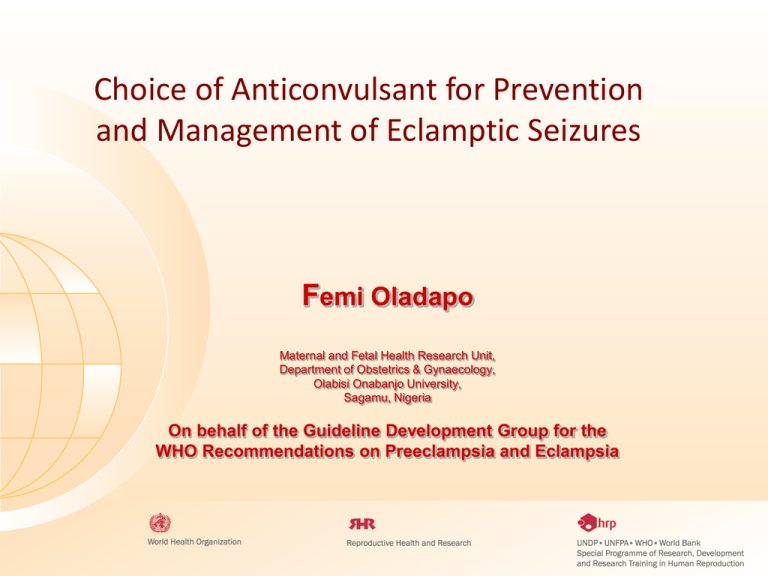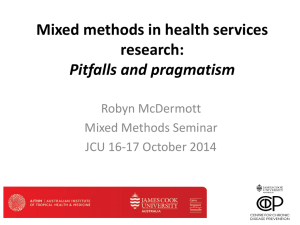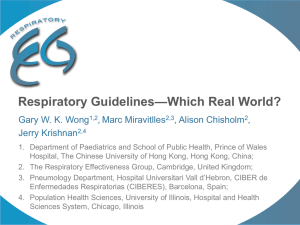Choice of anticonvulsant for PE-E, Femi Oladapo
advertisement

Choice of Anticonvulsant for Prevention and Management of Eclamptic Seizures Femi Oladapo Maternal and Fetal Health Research Unit, Department of Obstetrics & Gynaecology, Olabisi Onabanjo University, Sagamu, Nigeria On behalf of the Guideline Development Group for the WHO Recommendations on Preeclampsia and Eclampsia Outline • Background • Anticonvulsants for PE/E • WHO guideline development process • Evidence summary on clinical effectiveness • Interpretation of evidence • Implications for clinical practice Background • PE/E accounts for significant maternal and perinatal morbidity and mortality particularly in the developing countries • Stopping the progression of PE to E is key to improving outcome • Making the right choice of anticonvulsant is important for optimal care • Substandard care in management persists despite overwhelming evidence on effective interventions • Uncertain pathophysiology and associated multisystemic complications raise safety concerns regarding drug treatment Anticonvulsants for PE/E: magnesium sulfate • First introduced for eclampsia in the 1920s • Not a traditional anticonvulsant • Mechanism of action is poorly understood • Dosage regimens have evolved over the years • Side effects: Common: flushing Less common: nausea, vomiting, muscle weakness, thirst, headache, drowsiness and confusion Rare: respiratory depression, respiratory and cardiac arrest Anticonvulsants for PE/E: diazepam • A benzodiazepine • First suggested for eclampsia in the 1960s • A traditional anticonvulsant also used for a wide range of conditions • Core medicine in the World Health Organization's 'Essential Drugs List‘ • Common side effects: drowsiness, confusion and amnesia Anticonvulsants for PE/E: phenytoin • Suggested for eclampsia in the 1980s • Widely used for acute and long-term control of seizures • Acts as anticonvulsant without causing sedation • Prevents onset of but not useful for aborting seizures • Side effects: hypotension, cardiac arrhythmias, nystagmus and ataxia. Anticonvulsants for PE/E: lytic cocktail • Usually a combination of chlorpromazine (antipsychotic) promethazine (H1 histamine antagonist) and pethidine (opioid analgesic) • First introduced and used to be standard treatment in India • Individual component has sedative effects on the CNS • No longer in widespread use • Side effects: cardiac arrhythmias (chlorpromazine) hallucinations, incoordination (promethazine), seizures (chlorpromazine, promethazine and pethidine) WHO Guideline Development Process Assessment of need for guideline Stakeholders consultation to prioritize critical issues Secretariat to identify number and type of systematic reviews and other studies Establish clear timeline with individual/groups to retrieve evidence • Prioritization survey • Requests from Member States • Controversies around practices • IBP-KG discussion • ‘Scoping’ for relevant PICOT questions & critical outcomes • Cochrane systematic reviews • Other studies (RCTs, observational) • New systematic reviews? • Updating of existing reviews? Evidence synthesis • Reviews of effectiveness (GRADE appr.) • Quality of evid+ Strength of recommendatn Public (electronic) consultations • Online technical consultation on recomm. • Virtual global consultation Final recommendation expert panel meeting • Agreement on recommendations • Implementation plan & update Critical outcomes for WHO recommendations on PE/E Outcomes Proxy Eclampsia PE (if it is an intervention for preventing PE); Severe hypertension; Severe PE/HELLP Recurrence of convulsions -- Severe maternal morbidity Organ failure Maternal death -- Perinatal death Stillbirth, neonatal death, any baby death Admission to neonatal intensive care unit -- Apgar scores at 5’ < 7 -- Adverse events of intervention Toxicity (as defined); Calcium gluconate administration for MgSO4 Evidence summaries: prevention of eclampsia • A Cochrane review of 15 RCTs investigated the relative effects of anticonvulsants for prevention of eclampsia (Duley et al, 2010) Magnesium sulfate versus placebo or no anticonvulsants Magnesium sulfate versus phenytoin Magnesium sulfate versus diazepam Magnesium sulfate versus nimodipine Magnesium sulfate versus isosorbide Magnesium chloride with methyldopa. Magnesium sulfate and other anticonvulsants for prevention of eclampsia Evidence Source Eclampsia Any serious maternal morbidity Respiratory arrest Maternal death Any reported side effects Toxicity (resp. depr. + absent tendon reflexes Calcium gluconate given 5’ Apgar score < 7 Admission to NICU Stillbirth or neonatal death 1 RCT, n= 9992; RR 5.26, (4.59-6.03) 3 RCT, n=10,899; RR 5.96 (0.72-49.40) 2 RCTs, n=10,795; RR 1.35, (0.63-2.88) 1 RCT, n=8260; RR 1.02, (0.85-1.22). 1 RCT, n=8260; RR 1.01, (0.96-1.06) 3 RCTs, n=9961; RR 1.04, (0.93-1.15) Magnesium sulfate versus placebo or no anticonvulsants 6 RCTs, 11,444 women Evidence Quality 6 RCTs, n=11,444; RR 0.41, (0.29- 0.58) HIGH 2 RCTs, n=10,332; RR 1.08, (0.89-1.32) HIGH 1 RCT, n= 10,110; RR 2.50, (0.4912.88) 2 RCTs, n=10,795; RR 0.54, (0.26-1.10) HIGH HIGH HIGH MODERATE HIGH HIGH HIGH HIGH -- -- -- -- -- 1 RCT, n=2141; RR 0.58, (0.26-1.30) 1 RCT, n=2141; RR 1.00, (0.63-1.59) 1 RCT, n=2165; SB: RR 0.62, (0.27-1.41)/ ND: RR 0.26, (0.03-2.31) MODERATE MODERATE Magnesium sulfate versus phenytoin 4 RCTs, 2343 women Evidence Quality 3 RCTs, n=2291; RR 0.08, (0.01-0.60) -- MODERATE Magnesium sulfate versus diazepam 2 RCTs, 66 women Evidence Quality 2 RCTs, n=66; RR 3.00, (0.1369.31) -- -- -- -- -- -- -- -- -- -- -- VERY LOW Magnesium sulfate versus nimodipine 1 RCT, 1650 women Evidence Quality 1 RCT, n=1650; RR 0.33, (0.14-0.77) LOW -- MODERATE Evidence summaries: treatment of eclampsia • Three Cochrane reviews separately investigated the effects of magnesium sulfate compared to: Diazepam (Duley et al, 2000) Phenytoin (Duley et al, 2010a) Lytic cocktail (Duley et al, 2010b) Magnesium sulfate and other anticonvulsants for treatment of eclampsia - maternal outcomes Evidence Source Recurrence of convulsions Maternal death Any serious morbidity ICU Renal failure admission Pulm. oedema Resp. depr. Mech. 3 RCTs, n=1013; RR 0.86 (0.35 to 2.07) 3 RCTs, n=1025; RR 0.86 (0.57 to 1.30) 3 RCTs, n=1025; RR 0.73, (0.45 to 1.18) MODERATE MODERATE MODERATE 3 RCTs, n=902; RR 0.92 (0.45-1.89) 1 RCT, n= 775; RR 0.71 (0.46-1.09) 2 RCTs, n=825; RR 0.68 (0.500.91) MODERATE MODERATE CVA Cardiac arrest Coma >24 hours 4 RCTs, n=1225; RR 0.62, (0.32-1.18) 4 RCTs, n=1085; RR 0.80 (0.41 -1.54) -- ventilation Magnesium sulfate versus diazepam Cochrane review 7 RCTs, 1396 women 7 RCTs, n=1390; RR 0.43, (0.33-0.55) 6 RCTs, n=1336; RR 0.59, (0.38-0.92) 2 RCTs, n=956; RR 0.88, (0.64-1.19) 3 RCTs, n=1034; RR 0.80 (0.59, 1.07) Evidence Quality HIGH MODERATE MODERATE MODERATE 5 RCTs, n=1164; RR 0.85 (0.53-1.36) MODERATE Magnesium sulfate versus phenytoin Cochrane review 6 RCTs, 972 women Evidence Quality 6 RCTs, n=972; RR 0.34 (0.24-0.49) 3 RCTs, n=847; RR 0.50 (0.24-1.05) 1 RCT, n=775; RR 0.94 (0.73-1.20) 1 RCT, n=775; RR 0.67 (0.500.89) HIGH MODERATE MODERATE HIGH 3 RCTs, n=902; RR 1.52 (0.98-2.36) 1 RCT, n=775; RR 0.54, (0.20-1.46). 1 RCT, n=775; RR 1.16, (0.39-3.43) MODERATE MODERATE 1 trial, n=108; RR 0.22 (0.01-4.54). 2 RCTs, n=307; RR 0.26 (0.03-2.34) -- Magnesium sulfate versus lytic cocktail Cochrane review 3 RCTs, 397 women 3 RCTs, n=397; RR 0.06 (0.03-0.12) 3 RCTs, n=397; RR 0.14 (0.03-0.59) Evidence Quality MODERATE MODERATE -- -- 2 RCTs, n=307; RR 0.64 (0.22-1.85) -- 2 RCTs, n=198; RR 0.12 (0.02-0.91) LOW 1 RCT, n=90; RR 0.20 (0.014.05) 1 RCT, n=108; RR 0.04 (0.00-0.74) MODERATE Magnesium sulfate and other anticonvulsants for treatment of eclampsia - fetal outcomes Evidence Source Stillbirth Neonatal death Perinatal death Admission to Special care Nursery 5 ‘ Apgar score < 7 4 RCTs, n=759; RR 1.18 (0.75-1.84) 4 RCTs, n=788 ; RR 1.04 (0.81-1.34) 3 RCTs, n=634; RR 0.92 (0.79-1.06) 3 RCTs, n=643; RR 0.70 (0.54-0.90) MODERATE HIGH HIGH Magnesium sulfate versus diazepam Cochrane review 7 RCTs, 1396 women 5 RCTs, n=799; RR 0.97 (0.70-1.34) Evidence Quality Magnesium sulfate versus phenytoin Cochrane review 6 RCTs, 972 women Evidence Quality 2 RCTs, n=665; RR 0.83 (0.61-1.13) 2 RCTs, n=665; RR 0.95 (0.59-1.53) 2 RCTs, n=665; RR 0.85 (0.67-1.09) 1 RCT, n=518; RR 0.73 (0.58-0.91) 1 RCT, n=518; RR 0.86 (0.52-1.43) MODERATE MODERATE MODERATE HIGH MODERATE Magnesium sulfate versus lytic cocktail Cochrane review 3 RCTs, 397 women 2 RCTs, n=177; RR 0.33 (0.01-7.16) 2 RCTs, n=177; RR 0.37 (0.14-1.00). Any baby death: 2 RCTs, n=177; RR 0.35 (0.05-2.38) Evidence Quality VERY LOW VERY LOW VERY LOW -- -- Alternative magnesium sulfate regimens for treatment of pre-eclampsia and eclampsia • Evidence derived from a Cochrane review of 6 RCTs involving 866 women (Duley et al, 2010c) • 2 RCTs (451 women) compared regimens for eclampsia • 4 RCTs (415 women) compared regimens for PE Alternative magnesium sulfate regimens for treatment of PE and E Evidence Source Eclampsia Maternal death Recurrenc e of convulsio ns Any serious morbidity Renal failure Resp arrest Toxicity (Resp depr. Calcium gluconate given Any side effects Stillbirth or neonatal death Admissio n to SCBU 5’ Apgar score < 5 Stillbirth: 1 RCT n=401; RR 1.13 (0.661.92) -- -- -- -- -- -- -- -- Loading dose alone versus loading dose plus maintenance regimen for women with eclampsia 1 RCT, 401 women N/A Quality 1 RCT, n=401; RR 0.89 (0.37-2.14) 1 RCT, n=401; RR 1.13 (0.42-3.05) VERY LOW VERY LOW -- -- -- -- -- -- VERY LOW Lower dose regimens versus standard dose regimens over 24 hours for women with eclampsia N/A -- 1 RCT, 50 women 1 RCT, n=50R R 3.00, (0.1370.30). -- VERY LOW Quality Oliguria: 1 RCT, n=50, RR 0.20 (0.031.59) -- VERY LOW Absent tendon reflexes: 1 RCT, n=50; RR 0.25 0.06-1.06 -- -- -- VERY LOW Intravenous versus standard intramuscular maintenance regimen for 24 hours for women with pre-eclampsia 1 RCT, 17 women 1 RCT, n=17; RR Not estimable Quality VERY LOW -- -- -- 1 RCT, n=17; RR 3.33 (0.1571.90) -- VERY LOW 1 RCT, n=17; RR 3.33 (0.1571.90) -- -- VERY LOW 1 RCT, n=17; RR 1.25 (0.0917.02) VERY LOW Short versus standard (24 hours) duration of postpartum maintenance regimen for women with pre-eclampsia 3 RCTs, 398 women 3 RCTs, n=394; RR Not estimable Quality LOW -- -- -- -- -- 1 RCT, n=196; RR Not estimable LOW -- -- -- Evidence Interpretation • Evidence supports the use of magnesium sulfate in severe PE to prevent progression to eclampsia • Clear evidence that magnesium sulfate treatment in eclampsia reduces the incidence of further fits • Clear evidence that magnesium sulfate is more effective than diazepam, phenytoin and lytic cocktail in preventing further eclamptic fit • No clear evidence on which MgSO4 dosage regimen is better than the other • Most trials providing the evidence used clinical monitoring in women undergoing treatment and none used serum monitoring Implications for clinical practice • Development of WHO Recommendations on PE & E is currently underway • Magnesium sulfate is the drug of choice for preventing and treating convulsions in severe PE & E (WHO 2003. Managing Complications in Pregnancy and Childbirth) • Magnesium sulfate schedules for severe PE and eclampsia (WHO MCPC): Loading dose 4 g of 20% magnesium sulfate solution IV over 5 min Plus10 g of 50% magnesium sulfate solution IM (5 g in each buttock) Maintenance dose 5 g of 50% magnesium sulfate solution IM into alternate buttock every four hours If 50% solution is not available, give 1 g of 20% magnesium sulfate solution IV every hour by continuous infusion For recurrent convulsions: 2 g of 50% magnesium sulfate IV over 5 min THANK YOU







